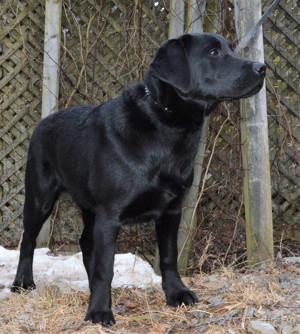Cruciate Ligament Rupture in Dogs

Fig.1
Normal Canine Tibia A. Femur B. Meniscus C. Tibia D. Tarsus E. Achilies Tendon F. Tibial Plateau |
|
What and where are the cruciate ligaments?There are two bands of bibrous tissue called the cruciate ligaments in each knee joint. They join the femur and bibia (bones above and below the knee) together so that the knee works as a hinged joint. They are called cruciate ligaments because they "cross over" inside the knee joint. One ligament connects from inside to outside the knee joint and the other outside to inside, crossing each other in the middle. Humans have the same anatomical structure of the knee. Cruciate ligament rupture is a common knee injury of athletes called "ACL". |

Fig.2
Intact Cruciate Ligaments A. Anterior B. Posterior 
Fig.3 Ruptured Cruciate Ligaments A. Anterior B. Posterior |
|
How does the injury occur?The knee joint is a hinged joint and only moves in one plane, backwards and forwards. Traumatic cruciate damage is caused by a twisting injury to the joint. This is most often seen in dogs and athletes when running and suddenly changing direction so that the majority of the weight is taken on this single joint. This injury usually affects the anterior (front) ligament. The joint is then unstable and causes extreme pain, often resulting in lameness. Many pets will "toe touch" and place only a small amount of weight on the injured leg. During the examination, the veterinarian will try to demonstrate a particular movement, called a drawer sign. This indicates laxity in the knee joint. Many dogs will require mild sedation or pain medications to perform this test. Other diagnostic tests such as radiographs (x-rays) may also be necessary. Other tests such as arthroscopy may be needed to rule out other damage to the joint. |
Is other joint damage common?
Inside the knee joint are pieces of cartilage called menisci. Many times these cartilages are also damaged when the cruciate ligaments rupture. They are usually repaired at the same time as the ligament surgery.

Fig.4
Tibial Plateau Leveling Osteotomy A. Tibial Axis B. TPLO Plate B. Tibial Plateau Axis (Arrow indicates direction of proximal tibial rotation) |
| What does surgery involve?There are various techniques available to replace the action of the cruciate ligament. These surgeries most often involve the placement of artificial ligaments along the outside of the knee joint. There is a newer surgical technique available called tibial plateau leveling osteotomy (TPLO) that is especially beneficial for larger, more athletic dogs. Your veterinarian will discuss with you the best treatment option for your dog. |
Is obesity such a problem?
Obesity can result in cruciate ligament rupture and knee arthritis. If your dog is overweight, the recovery time will be much longer. Obesity also increases the risk of injury to the other knee. Weight loss is as important as surgery in ensuring rapid return to normal function.
I was given this information by Dr. Don RUSHTON, one of only a very few in Canada that can repair a cruciate via the TPLO method.
Dr. RUSHTON can be contacted at:
Westwood Hills Veterinary Hospital
4 Westwood Blvd Hubley Centre
Upper Tanallon, Nova Scotia
Canada, B3Z 1H3
Tel: 902-826-1933
Fax: 902-826-9466



